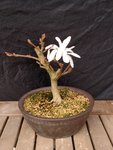Tidal Bonsai
Omono
Just added this to my collection today! Link to future progress found here:
 www.bonsainut.com
www.bonsainut.com
My First Rocky Mountain Juniper
First of all, I wanted to thank Randy Knight for collecting this beauty 3 seasons ago, and Jim Doyle of Nature’s Way for trusting me to care for it! Collected shohin size trees with good age are not easily found, I am very thankful to be able to add this to my collection!!! This tree is...




 Pomegranate with last year fruit. May 2020
Pomegranate with last year fruit. May 2020














